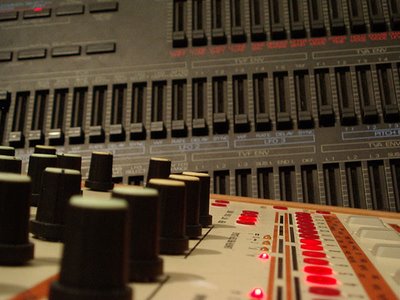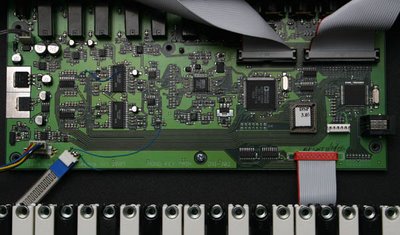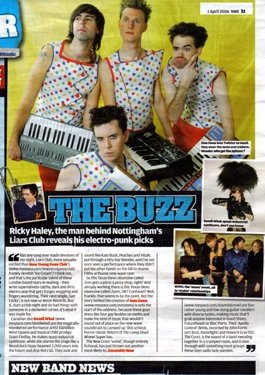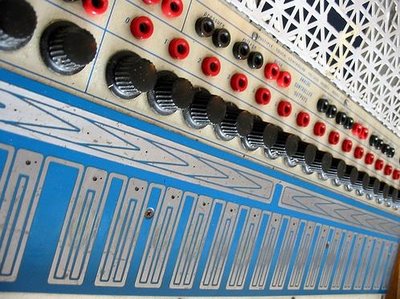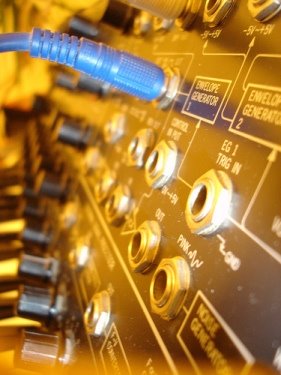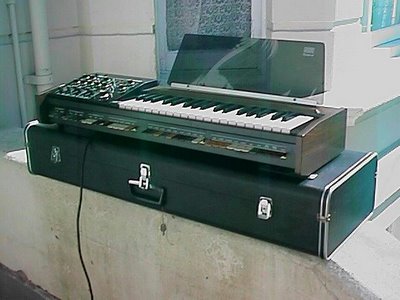

Tuesday, April 11, 2006
Roland JP-8080 Clipping?
Title link takes you to an interesting post by Don Solaris on Harmony Central regarding the Roland JP-8080 and clipping of its 12db filter. MuzikB was able to reproduce the behavior on a JP-8080, and I was able to somewhat reproduce it on a JP-8000. However, when I did, I was able to tame it by lowering the AMP Level on the JP8000, and I did not hear a difference in regards to clipping between the 12db and 24db filters. Also it only happened on one particular patch for me. Overall I do not get any clipping. My first thought was this kind of makes sense, but then I realized how much I had to turn the amp level down for the particular patch. If you have either a JP-8000 or JP-8080, try it yourself. Check out the thread for more detail.

Some of MuzicB's thoughts (read the thread for more):
"I mentioned the AMP level adjustment to Don earlier but also note that the signal is pretty tame with the occasional amplitude increase into clipping across certain frequencies. You can adjust the AMP level but the jumps still occur. The more I think about it, the more I believe that this isn't a bug or a mistake on Roland's part but that it was made to react this way.
I'll mess around some more tomorrow as it's getting late.
Keep up that great blog matrix!"
I especially like that last thought. : ) Thanks MuzicB!
Update via Don Solaris:
"I would like clear out some things. AMP setting has not much with this issue. The AMP level was at standard 64/127 value. The only thing we can do with AMP is introduce more distortion due its own nonlinearity, but that has nothing to do with the filter overload issue i am talking about. If we take a value of 64 as a standard 0dB gain, when we set it to 127 we are pushing Amplifier into its own nonlinear area which introduces new distortions (due to additional positive gain).
It is a normal thing when you reduced AMP that distortion got lower. But this is true just for values above 64 (say, reducing from 127 to 70). Below 64, you can't reduce the distortion. If you don’t believe me, do the following: Reduce AMP level below 50 and increase the main volume. You will hear distortion is still present. Or try another one. Put AMP level to max and Main level to low, play a note, you will hear distortion. Now put AMP level to low and Main level to high value - distortion is still here. (Please use headphones).
I think this should be also stated in Matrixsynth blog (which i enjoy reading) as people might think they can solve this issue by reducing AMP level. Unfortunatley that is just not possible as AMP is located post filter. And we should not confuse AMP's own distortion (due to its own nonlinearity), with this filter overload issue.
Keep up the good work Matrix, and thanks for putting this on synthblog."
No problem. Thanks Don.

Some of MuzicB's thoughts (read the thread for more):
"I mentioned the AMP level adjustment to Don earlier but also note that the signal is pretty tame with the occasional amplitude increase into clipping across certain frequencies. You can adjust the AMP level but the jumps still occur. The more I think about it, the more I believe that this isn't a bug or a mistake on Roland's part but that it was made to react this way.
I'll mess around some more tomorrow as it's getting late.
Keep up that great blog matrix!"
I especially like that last thought. : ) Thanks MuzicB!
Update via Don Solaris:
"I would like clear out some things. AMP setting has not much with this issue. The AMP level was at standard 64/127 value. The only thing we can do with AMP is introduce more distortion due its own nonlinearity, but that has nothing to do with the filter overload issue i am talking about. If we take a value of 64 as a standard 0dB gain, when we set it to 127 we are pushing Amplifier into its own nonlinear area which introduces new distortions (due to additional positive gain).
It is a normal thing when you reduced AMP that distortion got lower. But this is true just for values above 64 (say, reducing from 127 to 70). Below 64, you can't reduce the distortion. If you don’t believe me, do the following: Reduce AMP level below 50 and increase the main volume. You will hear distortion is still present. Or try another one. Put AMP level to max and Main level to low, play a note, you will hear distortion. Now put AMP level to low and Main level to high value - distortion is still here. (Please use headphones).
I think this should be also stated in Matrixsynth blog (which i enjoy reading) as people might think they can solve this issue by reducing AMP level. Unfortunatley that is just not possible as AMP is located post filter. And we should not confuse AMP's own distortion (due to its own nonlinearity), with this filter overload issue.
Keep up the good work Matrix, and thanks for putting this on synthblog."
No problem. Thanks Don.
When Robots Compose
Asperges Me
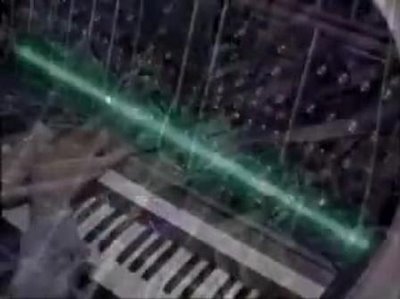 Ran into this one checking out this post on Music Thing. Title link takes you to there. Be sure to check out the other videos on the right when you get there for some Fairlight and Mellotron videos.
Ran into this one checking out this post on Music Thing. Title link takes you to there. Be sure to check out the other videos on the right when you get there for some Fairlight and Mellotron videos.
Waldorf Wave For Sale
Don't see these up for sale often. $7k US gets you the mother of all wavetable synths.

Title takes you to the auction while it's up. PS. I have no affiliation with this.
Details from auction:
"Finally! Waldorf Wave for sale - Excellent condition/mint. New display and newly gone through service. 16 voice polyphony. Ace of Bace Jonas Berggren "Buddha" first owner, bought new by him. After this only one second owner. Serial #: 94 04 00 00 24 Contact Studio Lärje/Gothenburg for more information. "

Title takes you to the auction while it's up. PS. I have no affiliation with this.
Details from auction:
"Finally! Waldorf Wave for sale - Excellent condition/mint. New display and newly gone through service. 16 voice polyphony. Ace of Bace Jonas Berggren "Buddha" first owner, bought new by him. After this only one second owner. Serial #: 94 04 00 00 24 Contact Studio Lärje/Gothenburg for more information. "
Peter Kirn's Real World Digital Audio
 I finally got around to spending some quality time with Peter Kirn’s Real World Digital Audio, and I must say it's solid. You might recognize his name; Peter runs the Create Digital Music blog. This is a great book for both people new to the subjects covered, and those experienced. Flip through the book, pick a chapter that interests you and dig in, or read it from front to back. As an aside, I find that I spend most of my time behind a monitor. Being able to take some time off and kick back with a paperback filled with all of this information was refreshing. Note this is a long post; I wanted to touch on each chapter so you'd have a good idea on what's covered. Don't miss the QA at the end for why Peter wrote this book and what he hopes people to get out of it.
I finally got around to spending some quality time with Peter Kirn’s Real World Digital Audio, and I must say it's solid. You might recognize his name; Peter runs the Create Digital Music blog. This is a great book for both people new to the subjects covered, and those experienced. Flip through the book, pick a chapter that interests you and dig in, or read it from front to back. As an aside, I find that I spend most of my time behind a monitor. Being able to take some time off and kick back with a paperback filled with all of this information was refreshing. Note this is a long post; I wanted to touch on each chapter so you'd have a good idea on what's covered. Don't miss the QA at the end for why Peter wrote this book and what he hopes people to get out of it. So, what is the book about and what can you expect from it? Simply put it's a book about audio production and how to set up a home studio in the most practical sense. What's cool about it and what makes it stand out from other tutorials is that it goes into some depth on how things work - the theory behind how and why you apply certain techniques. BTW, it's filled with tips, links to other resources, tutorials and more. It's written and designed to help de-mystify technique and process. The book actually starts with an excellent chapter on sound theory. It is well written, easy to follow, rich in content, and it provides links to more extensive documentation if you want it.
References to more in-depth information are actually one of two recurring themes in the book that I really appreciated. The other is solid examples and walk-throughs that you can do yourself. Peter solidly lays the foundation for each topic and then provides tutorials and links to more when appropriate. Note that the book is standard college book size and roughly 615 pages long. I found that the level of depth for each topic was nearly perfect in most cases. BTW, the book would make an excellent college course and is meant to be a self study and handbook. It has solid and practical content that you can actually use and build a foundation on. If I had a friend who wanted to get into music production, I'd buy her this book, and I'm sure that after reading it she'd probably be teaching me a few things. : )
So, will a lot of the material be redundant to what you already know? Maybe. Everyone has their own level of experience in audio. You will probably find that you have some chapters covered and others not. Some of this will be familiar to you, but think of it as a good way to reinforce your ego. ; ) To be honest I actually did find little nuggets of information that I did not know in areas I considered myself to be well versed, and sometimes these little nuggets are worth more than a whole chapter. I also found that some of the topics that I didn't expect to be interested in at all were completely fascinating to me (Mics for example in Chapter 6 Recording Instruments and Sound).
The following are the chapters in the book.
Chapter 1: Understanding Digital Sound
This was my kind of chapter. Simply put it covers how sound works. The physical waves and characteristics of sound, how we perceive it and how it is handled in digital form. If you want to know more about bit rates, phase cancellation, signal-to-noise, partials, etc, this chapter covers it.
Chapter 2: Choosing Your Tools
This chapter focuses on the basics behind setting up your hardware and software focused on audio workstation recording (instruments and effects are covered in later chapters). Things like inputs and outputs, choosing the right computer, and music and sound production tools are covered.
Chapter 3: Setting Up Your Equipment
This chapter focuses on how to set up your physical studio such as considering ergonomics, sound isolation, speaker placement, connector types, voltage levels, noise and hum, etc.. Some really good bits in this chapter.
Chapter 4: Preparing Your Computer for Audio
This chapter focuses on setting up your virtual studio. It includes tips on installing and setting up audio hardware and software, optimizing your system and getting the latest driver updates.
Chapter 5: Quick Songs with Patterns and Loops
This is a fun interactive chapter where Peter walks you through setting up loops with either GarageBand on Mac or Kinetic on PC (demo versions of both are included in the CD that comes with the book).
Chapter 6: Recording Instruments and Sound
This chapter is broken up between the characteristics of different mics, placement and positioning of mics for different recording techniques, and digital recording in general including setting levels, monitoring and different recording methods. Again, this chapter surprised me in that I thought I would have little interest in mics in general. It was a fascinating read for me being new to the subject
Chapter 7: Processing and Effects
This chapter covers everything you want to know about effects. What's awesome about Peter's book is that he goes into how and why things work. The chapter covers the Basics of Signal Processors, Equalization, Dynamics Processors (compressor, limiter, expander, etc..), Time-Related Effects (delay/echo, reverb), and Specialized Processors (distortion, modulation, pitch correction, etc).
Chapter 8 MIDI: Notes, Rhythms, and Physical Control
This chapter is cool. It covers the basics like connecting your MIDI devices and it covers things like recording and editing your MIDI performances, but it also includes things like the Anatomy of a MIDI Message. Again this is not a technical book on audio so you won't get a in depth MIDI manual here, but what you do get is good solid overview of how MIDI works beyond just hooking up a controller and banding on some notes.
Chapter 9: Synthesis and Software Instruments
Ok, I admit this along with Chapter 4 are my areas of expertise, so... It was awesome! I approve. : ) The chapter starts with an overview of synthesis including different types of synthesis and.... It encourages you to make your synth you! It encourages the reader to program their own sounds. The chapter covers sampling, the building blocks of synthesis including oscillators, envelopes, filters, modulation, etc. Way to go Peter! I love that anyone that might go through this book not being familiar with synthesis, will now have a tutorial like this. Too cool. NOTE: this along with much of the rest of the book could easily have just been a quick "10 step" guide to hooking up your studio. What's awesome about this book is that it presents how to do things with why behind it. It appreciates the theory and reasoning that goes into setting up a good studio.
Chapter 10: Put It Together: Arrange, Mix, and Master
This chapter covers Arranging, Mixing, Mastering and Sharing your work. This chapter is the meat and potatoes section of laying and mixing tracks. Things like arrangement view and timeline, slices and beats, spatialization, dithering and export quality are just a few of the things covered in this chapter.
Chapter 11: Producing Printed Scores
This chapter focuses on notation software. This is the meat and potatoes chapter on writing and editing notation.
Chapter 12: Music and Sound for Video
This chapter covers synchronization (matching sound and image), timing and notation, performing with live musicians, postproduction and more.
Chapter 13: Playing Live
This chapter covers how to play soft synths live, using audio inputs and effects with real time control, live sampling, djing with a computer, and more.
So do I recommend this book at the asking price? Yep. It's worth it. I would take a look at the chapters above and ask yourself if one, could you use it, and two are there topics you would enjoy reading on a lazy afternoon? If the answer is yes to either of these, get it.
This is a great book Peter, congratulations on this acheivement!
1) Why did you write the book?
"I really felt that a general reference on making music with computers,
written in a way that beginners could approach but that was also
thorough and up-to-date, was missing. What the average musician does
with computers has expanded so much. It's not just recording, it's not
just mixing. It's also playing soft synths and designing sounds and
composing and arranging and scoring and so on. I wanted to see a
big-picture book that put practical information on all these topics in
one place, without being overwhelming.
It happened that I talked to Chris Breen at Macworld about this, and
learned Peachpit was looking for just such a book. I didn't originally
intend for me to be the author, to be truthful, but that's how things
often happen.
After you finish a book you hopefully have more perspective on the
process than while you're in the middle of it, or at least that was
the case for me. For me this was a way of condensing a lot of
knowledge out there into a central location, not only my own knowledge
but what I've learned from all sorts of great teachers. I've been
reading a lot of other books lately -- non-music books, as I've been
programming visual work in 3D environments -- and it's great to have
that experience with other people's writing. Even as a web-based
writer, I'm totally dependent on paper, and on the unique ways you can
express information in book form."
2) What do you hope people will gain from the book?
"I really wanted to convey the fundamentals of music production
techniques, beyond the specifics of certain applications. You'll see
plenty of illustrations, but for me what lets you sit down and make
music is feeling comfortable with the language and the interfaces you
see. I certainly love getting a new synth and playing with mysterious
knobs and such, but you also want to be able accomplish what you're
trying to do, to focus on sound and what you imagine, and to deal with
all the technical issues that could otherwise slow you down.
And it's certainly not an endpoint -- hopefully a book gets you
started on topics, and makes you want to read and learn more. I think
I'll have to start a running web bibliography for RWDA, because people
are already asking "where do I go next?" which is fantastic."
3) How do you recommend people read the book?
"This is entirely dependent on where you are, because we worked really
hard on making it compatible with a broad audience.
It should be completely possible to start on page 1 and read to the
end. We talked a lot about how to go from one element to another, to
make it readable. I also tried to design the hands-on examples so that
you could work through chapters -- particularly after the first third
of the book, once you get into more practical stuff -- and try things
out. There's the demo software on the DVD for that purpose, some of
which, happily, you can use indefinitely. (Even the Ableton Live demo
is pretty functional without purchasing it.) That's important, because
if you haven't yet chosen your software tools, you can try this stuff
out and get a taste, and make a more informed decision about which way
you want to go. But if you do have software tools of choice, I tried
to be careful about covering ideas that apply from one program to
another. I often wrote chapters with Cubase, Pro Tools, Logic, Digital
Performer, SONAR, and Live all running, looking from one to another.
So, that's the linear approach. But it's also designed as a reference
book. For people who are more experienced, I expect they're more
likely to use it that way, either to brush up on a topic by picking up
a chapter or just to refer to it occasionally. Something very fun has
happened for me, which is I can now pick it up as a reference."
Monday, April 10, 2006
The Electronic Peasant's Solid State Percussion Synth

Additional details at The Electronic Peasant
That's a whole lotta knobs; 144 of them according to Magnus Olfsson. You might recognize the Peasant from this post. Thanks Magnus!
Korg - New Flickr Shot
The Micron Mirror Box - New Flickr Set
 What the... A toaster for a Micron! Title link takes you to the first shot in the set explaining what this is. There's a how-to included if you want to make something like this for one of your synths. Hmm... Somone should manufacture these. Could have been on that American Inventor TV show. : )
What the... A toaster for a Micron! Title link takes you to the first shot in the set explaining what this is. There's a how-to included if you want to make something like this for one of your synths. Hmm... Somone should manufacture these. Could have been on that American Inventor TV show. : )
The Korg PE1000
 Korg's first polyphonic keyboard. What's interesting is this SOS article implies that the PE1000 was in essence only capable of electric piano sounds, while the PE2000 that followed it included organ, brass, chorus and strings.
Korg's first polyphonic keyboard. What's interesting is this SOS article implies that the PE1000 was in essence only capable of electric piano sounds, while the PE2000 that followed it included organ, brass, chorus and strings. "The PE1000 was, in essence, a 61-note electronic piano with seven voices differentiated by preset values of the Traveler and envelope. Some control was available, but with a single oscillator per note, no touch-sensitivity, and just a single filter and envelope for the whole keyboard, it was very limited. Nonetheless, the PE1000 was soon to be seen in some respected company; Vangelis used one, as did Jean-Michel Jarre.
The 48-note PE2000 was a traditional string synth, with a richer sound produced by eight organ, brass, chorus and string presets. "
However, Audio Playground shows its specs including string, pipe organ, brass, electronic piano, piano and harpsichord. Title link takes you to the Audio Playground site with more shots and info.
I confirmed midway through this post with Dennis Verschoor that the PE1000 does indeed have the additional sound options like the PE2000. Interesting that SOS would be wrong here. Dennis sent me this link to more shots (btw, this link is currenlty timing out for me, so posting it in case it comes up later or comes up for you). He is selling this one for 350 euro. It was his post for sale on AH that inspired me to look into the keyboard and ultimately lead to this post. You can email Dennis here if you are interested: modular[]gmail.com
Update: Shots also saved here. You can clearly see the presets for String, Pipe Organ, Brass, Electric Piano, Piano, Harpsichord, and Clavichord.
DSI Polyevolver on Synthwire
Linn LM1
 Title link takes you to shots pulled from this auction. Note the address on the back of the unit. I decided to look it up just out of curiosity as I grew up in Hollywood. Turns out it's this house. I'm guessing it was Roger Linn's pad back then. If anyone knows feel free to comment. I'm left wondering how many other gear makers do this and why Linn would do this. Kind of interesting....
Title link takes you to shots pulled from this auction. Note the address on the back of the unit. I decided to look it up just out of curiosity as I grew up in Hollywood. Turns out it's this house. I'm guessing it was Roger Linn's pad back then. If anyone knows feel free to comment. I'm left wondering how many other gear makers do this and why Linn would do this. Kind of interesting....
Synthoma Analog Synth Repair
 Title link takes you there. Some nice shots under the gallery. Synthoma is located in Barcelona. Via Moogulator. I love Bob Moog's shirt in this shot. Green. : )
Title link takes you there. Some nice shots under the gallery. Synthoma is located in Barcelona. Via Moogulator. I love Bob Moog's shirt in this shot. Green. : )
Sunday, April 09, 2006
Satin on Gnostic Rocket
Waldorf XTk Demo
Dance Planet Studio
Analog Synthesizers - Video by Marc Doty
Uploaded on Mar 20, 2006 AutomaticGainsay
"Here are some analog synthesizers so that you may know them when you experience them again.
The score is provided by Automatic Gainsay.
Special bonus points for anyone who can name all the synthesizers featured. : )"
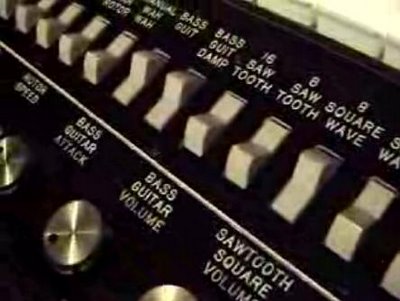
BTW, anyone know what the synth in this shot is, and what the heck is the Hawaii Effect? : ) [Update: here it is!]
Update via the comments:
"Actually, it is a Wersi Bass synthesizer, but it is the KIT version. I bought it on eBay. It doesn't work very well, but I'm going to have a Wersi expert look at it.
Thanks for the nice comments about the video..."
You're welcome. : )
Roland SH-101 Demo on PunkDisco
 I couldn't find a shot of a 101 on PunkDisco, so here a Future Retro 777 instead. Trippy shot.
I couldn't find a shot of a 101 on PunkDisco, so here a Future Retro 777 instead. Trippy shot. Title link takes you to the PunkDisco music page. The third track, Letting Go, showcases the Roland SH-101.
"Not a proper track but rather a few hours of messing around to demo a sh101 (the main synth/bassline)
All sequenced from the 101 with no synchronisation. The 101 variation is just pushing the bender to modulate the VCO and VCF a bit. Audio recorded straight into Ableton Live which then took care of sync'ing. http://www.punkdisco.co.uk/Music.htm Letting Go (3rd track down)
I had to list it 3rd down as fello punkdISCO, Leah, hates the track for a few irrational reasons; the main one being that she was not involved.. Besides, its not a track - its a sh101 demo..
Drums = Airbase
Bells and whistles = Evolver
hugs,
Paul"
Saturday, April 08, 2006
HCGPF on Analog Industries
And it's a synth one. Memorymoog, Jupiter-8, DX1, OB-Mx, Matrix-12 and more. Title link takes you there.
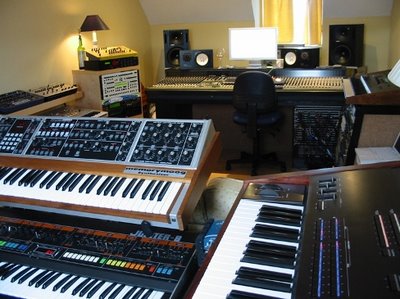

Friday, April 07, 2006
Microsoft Monaco
Interesting. Looks like Microsoft will come out with their version of GarageBand.
"Microsoft is still pushing full-steam-ahead with a music-making program, code-named "Monaco," according to Microsoft partners who requested anonymity. Monaco would be very similar to Apple's GarageBand application, but would be optimized to take advantage of Windows Vista and the Aero user interface."
"Microsoft is still pushing full-steam-ahead with a music-making program, code-named "Monaco," according to Microsoft partners who requested anonymity. Monaco would be very similar to Apple's GarageBand application, but would be optimized to take advantage of Windows Vista and the Aero user interface."
Polivoks Filter Clone
 Title link takes you to the Polivoks Filter Clone site by Marc Bareille.
Title link takes you to the Polivoks Filter Clone site by Marc Bareille. James R. Coplin built one and recorded this 261k MP3 of the clone. Check it out. It's a wicked sounding filter.
James on the filter:
"I just got done putting a Polivoks filter together on a breadboard and thought some folks might like to hear how it sounds. The filter is from Marc Bareille's adaptation and sounds like drinking vodka through broken lips and teeth must feel! A big thanks to Marc for all his help. I will be posting full details of the project with some additional adaptations that Marc told me about to use some hard to get parts. I'm thinking I need about 4 of these in my rig." "The thing has *no* caps in the filter and has a very strange resonance characteristic as a side effect. At extreme settings instead of producing a sine wave, it makes a squarish wave and eventual kind of craps out as you can hear.
The patch was just three saws running in and then out through a vca. There was *no* distortion added or sync on the osc. All that grunge is from the filter itself. I wouldn't want one as my only filter but I got to tell you, this thing is wonderful. I'm not exaggerating when I say I'm building 4 of them for my rig. Processing drums with these is lovely."
x0xb0x #150
Thursday, April 06, 2006
Cwejman Modular Shots and PDFs
 Title link takes you to some shots and pdfs on Analogue Haven. Note how thin these are.
Title link takes you to some shots and pdfs on Analogue Haven. Note how thin these are.
Sequential Circuits T8 Shots
 Title link takes you to more shots pulled from this auction. Something about synth shots in nature. And of course... Green.
Title link takes you to more shots pulled from this auction. Something about synth shots in nature. And of course... Green.
Mad About Metasonix
 Michael Weeks sent me a couple of links to shots of Josh Adam's studio. The first link takes you to Josh's website, Neopolitan Labs (make sure to check out the gallery). I asked Michael if Josh had any association with Metasonix considering the number of modules he owns. He said no, but Eric Barbour of Metasonix did pay him a visit. The shots here are from that visit. (Direct links for when the posts are no longer current: one, two, three).
Michael Weeks sent me a couple of links to shots of Josh Adam's studio. The first link takes you to Josh's website, Neopolitan Labs (make sure to check out the gallery). I asked Michael if Josh had any association with Metasonix considering the number of modules he owns. He said no, but Eric Barbour of Metasonix did pay him a visit. The shots here are from that visit. (Direct links for when the posts are no longer current: one, two, three)."Eric visited Josh's new studio being built in San Francisco, with analog synths everywhere and a literal army of Metasonix boxen (including NINE Agonizers, four Butt Probes, and at least two of everything else. And now, sixteen TM-6s.)
He says the photos only show a small fraction of it, much of the gear is still packed or being used by Josh's partner. Apparently, Josh hates software synths, even though he's a programmer."
Off The Top of My Head - Jason Nazarof's Studio
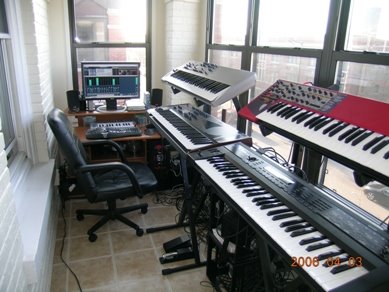 Jason Nazarof sent in the following shot of his studio. Click on the image for a bigger shot. Title link takes you to Jason's MySpace site where you can hear this gear being put to use. Really good stuff.
Jason Nazarof sent in the following shot of his studio. Click on the image for a bigger shot. Title link takes you to Jason's MySpace site where you can hear this gear being put to use. Really good stuff. Gear in shot:
Roland D-50
Nord Lead 2
Novation X-Station
Access Virus TI
M-Audio O2
PC Running Nuendo
Mbox
Nuxx's x0xb0x and Paia Fatman
Slayer Mod Updates
Wednesday, April 05, 2006
Boss SYB-3 Watch
 Title link takes you to shots pulled from this auction. Details saved below for posterity. Via Music Thing.
Title link takes you to shots pulled from this auction. Details saved below for posterity. Via Music Thing.Details from auction:
"This is very rare opportunity to own Boss Effecter Pedal (Bass Synthesizer SYB-3 pedal) shaped watch in as new condition. I have replaced the battery prior to listing this auction.
This watch never been used and it is about 6 years old. This was given to me by supplier in Japan for Promotion / Campaign. Please note that you cannot buy this watch and they only produced one hundred of them (well that is what I got told) for the promotion.
This will make perfect gift for someone musical / guitarists / bass players or why not you show your musical side in the fashion.
Comes with an original case."
Moog Phatty Q&A on MusicThing
Superbuth - Vinyl and a Big Red Button
 Title link takes you to a monster video of the Musikmesse's Superbuth on Sonic State. Amazing analog gear fest.
Title link takes you to a monster video of the Musikmesse's Superbuth on Sonic State. Amazing analog gear fest. Features, Doepfer, LiveWire, Macbeth, MFB, Curetronic, Vermona, Sherman, Metasonix, Studio Electronics, JoMoX, Sequentix, Semblance, and more.
Watch the video and realize the power of Vinyl and on big red Mungo Sync button.
PREVIOUS PAGE
NEXT PAGE
HOME













© Matrixsynth - All posts are presented here for informative, historical and educative purposes as applicable within fair use.
MATRIXSYNTH is supported by affiliate links that use cookies to track clickthroughs and sales. See the privacy policy for details.
MATRIXSYNTH - EVERYTHING SYNTH













© Matrixsynth - All posts are presented here for informative, historical and educative purposes as applicable within fair use.
MATRIXSYNTH is supported by affiliate links that use cookies to track clickthroughs and sales. See the privacy policy for details.
MATRIXSYNTH - EVERYTHING SYNTH


